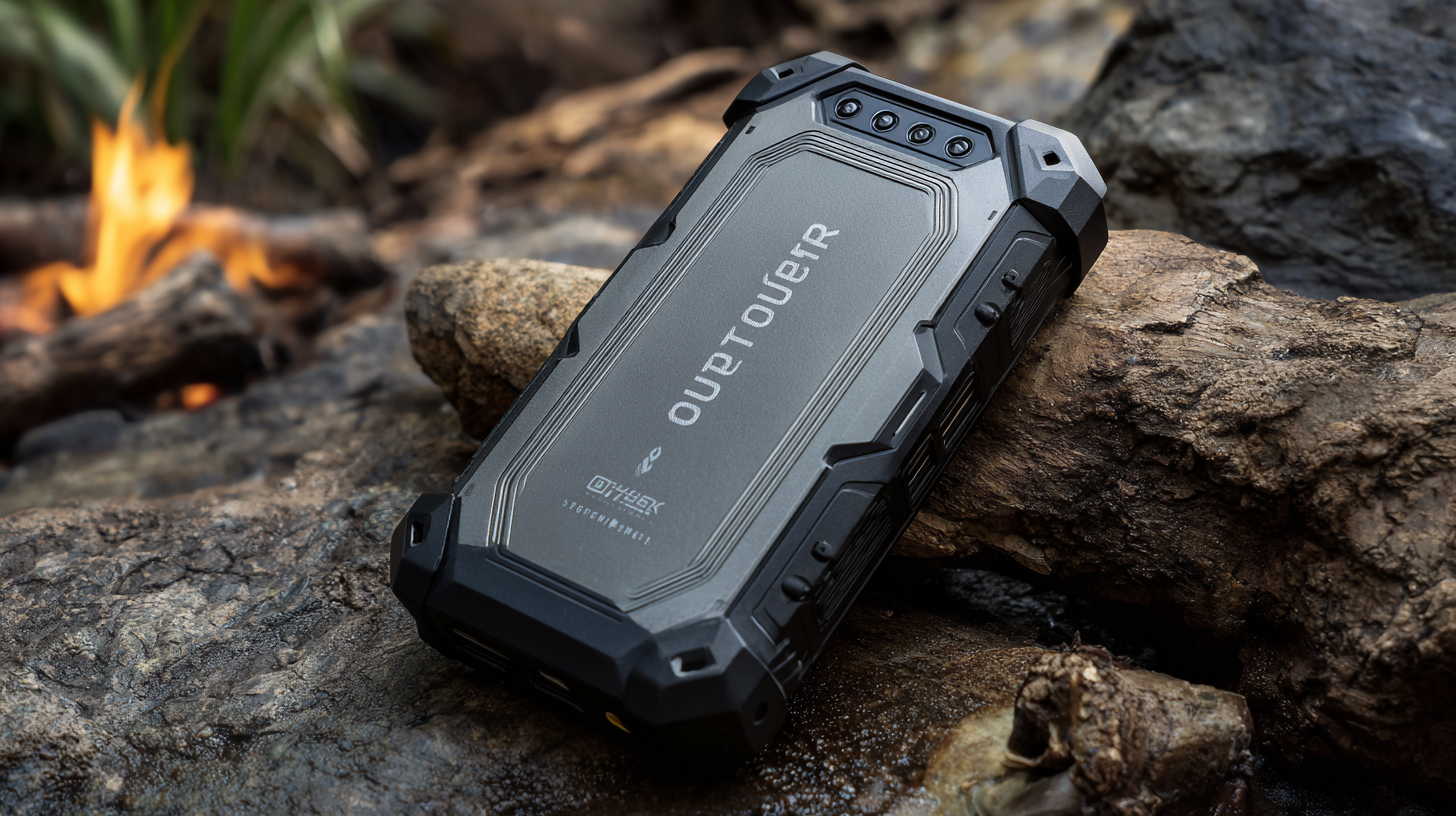
Innovative Use Cases of Best Outdoor Power Banks in Adventure Tourism and What You Need to Know
In the realm of adventure tourism, the integration of technology has revolutionized the way explorers engage with the great outdoors. As reported by the Adventure Travel Trade Association, over 60% of adventure travelers rely on portable power solutions to keep their devices charged while on the go.
 Enter the Outdoor Power Bank, a crucial accessory that ensures travelers remain connected, document their journeys, and access navigation tools without the fear of running out of battery. With a growing market projected to reach $1.3 billion by 2026, understanding the innovative use cases of outdoor power banks is essential for both avid adventurers and industry stakeholders.
This blog will explore various applications and comparisons of the best outdoor power banks, equipping readers with the knowledge needed to enhance their outdoor experiences while remaining powered up in any environment.
Enter the Outdoor Power Bank, a crucial accessory that ensures travelers remain connected, document their journeys, and access navigation tools without the fear of running out of battery. With a growing market projected to reach $1.3 billion by 2026, understanding the innovative use cases of outdoor power banks is essential for both avid adventurers and industry stakeholders.
This blog will explore various applications and comparisons of the best outdoor power banks, equipping readers with the knowledge needed to enhance their outdoor experiences while remaining powered up in any environment.
Innovative Power Solutions: The Rise of Outdoor Power Banks in Adventure Tourism
The rise of outdoor power banks has revolutionized adventure tourism, catering to the needs of modern explorers who require reliable power solutions while venturing into remote landscapes. As outdoor enthusiasts engage in activities like hiking, camping, and biking, the demand for innovative energy sources has surged. These versatile devices not only keep essential gear charged but also enhance safety and connectivity in the great outdoors.
Outdoor power banks have evolved to feature rugged designs, water resistance, and solar charging capabilities, making them ideal companions for adventurous outings. With capacities ranging from compact models for light travelers to high-capacity power stations for extended trips, these devices can charge everything from smartphones to GPS devices, ensuring that tourists are never out of touch. Moreover, the growing use of solar technology allows travelers to harness natural energy, reducing their carbon footprint while embracing sustainability.
As adventure tourism continues to gain traction, the importance of dependable power solutions cannot be overstated. Equipped with outdoor power banks, adventure seekers can immerse themselves in their surroundings without the worry of losing power during critical moments. This innovative shift not only enhances the overall experience but also empowers travelers to capture and share their journeys like never before.
Innovative Use Cases of Best Outdoor Power Banks in Adventure Tourism
| Use Case | Power Bank Type | Battery Capacity (mAh) | Weight (grams) | Key Features |
|---|---|---|---|---|
| Hiking & Trekking | Solar Power Bank | 20000 | 450 | Waterproof, Solar Charging |
| Camping | Portable Power Station | 50000 | 5000 | Multiple Outlets, Fast Charging |
| Cycling | Slim Power Bank | 10000 | 200 | Lightweight, USB-C Output |
| Rock Climbing | Rugged Power Bank | 15000 | 300 | Shockproof, High Durability |
| Fishing | Water-Resistant Power Bank | 25000 | 400 | LED Indicators, Fast Recharging |
Consumer Demand Analysis: Growth Trends in Portable Energy Sources for Travelers
The demand for portable energy sources is witnessing a significant upward trend, particularly in the realm of adventure tourism. As travelers increasingly seek out outdoor experiences, the need for reliable and efficient power banks has surged. According to industry reports, the portable power station market is set to grow remarkably, with projections indicating an increase from $299.4 million in 2025 to approximately $504.95 million by 2032, reflecting an annual growth rate of 8.04%. This growth is driven by the rising popularity of off-grid living and the need for emergency power supplies, making innovative outdoor power banks essential gear for adventure enthusiasts.
Additionally, the outdoor cooking equipment market mirrors this trend, with expectations for substantial expansion from 2024 to 2032. As consumers embrace outdoor culinary experiences, the demand for portable cooking solutions, such as grills and stoves, is escalating. The focus on sustainability and convenience in travel further fuels this market, positioning portable energy solutions as crucial companions for travelers seeking both adventure and comfort in remote locations. As these industries evolve, the integration of advanced technology in portable power sources will likely enhance user experiences and meet the growing expectations of modern adventurers.
Consumer Demand Analysis: Growth Trends in Portable Energy Sources for Travelers
Case Studies: Successful Integration of Power Banks in Outdoor Adventure Experiences
In the burgeoning sector of adventure tourism, the integration of technology has become paramount, with outdoor power banks playing a crucial role in enhancing the experience. A recent report from the Outdoor Industry Association highlights that 54% of outdoor enthusiasts consider charging capabilities essential during their adventures. This reflects a growing demand for reliable power sources as travelers increasingly rely on devices for navigation, communication, and documentation of their journeys.
Case studies demonstrate successful implementations of power bank solutions in adventure tourism. For instance, a hiking company based in the Pacific Northwest has equipped its guided tours with portable charging stations, allowing participants to recharge devices at designated rest points. This innovative approach not only improves the customer experience but also boosts engagement, as travelers can share their experiences in real-time on social media.
Furthermore, a ski resort in Colorado has partnered with power bank providers to offer rental services on-site, leading to a 30% increase in customer satisfaction ratings as reported in a recent survey by Adventure Travel Trade Association. These examples underline how integrating outdoor power banks into adventure tourism can significantly elevate the overall experience while meeting the expectations of modern adventurers.
Durability and Efficiency: Evaluating the Best Outdoor Power Banks for Harsh Environments
When it comes to adventure tourism, the durability and efficiency of outdoor power banks are paramount. Recent data from the Outdoor Industry Association indicates that approximately 48% of adventure travelers prioritize reliable technology to keep their devices powered during outdoor excursions. As a result, manufacturers are increasingly focused on designing power banks that can withstand extreme conditions such as heavy rain, high temperatures, and rough terrain. For instance, the IP67 rating, which signifies dust-tight and water-resistant capabilities for up to 30 minutes in 1 meter of water, is becoming a benchmark among premium models.

Additionally, battery efficiency plays a crucial role in the practicality of outdoor power banks. A study from Consumer Reports revealed that units capable of fast charging and those with higher energy density—measured in watt-hours per kilogram (Wh/kg)—are favored by adventurers who need to maximize their power supply. Products that offer at least 20000mAh are recommended for longer trips, ensuring multiple devices can be charged without frequent recharges. As adventure tourism continues to gain popularity, selecting robust and efficient power banks will help outdoor enthusiasts stay connected and safe in the wild.
Future Trends: How Technology is Shaping the Next Generation of Outdoor Power Banks
As adventure tourism continues to grow, the demand for reliable outdoor power banks is evolving to meet the needs of tech-savvy travelers. Future trends indicate that the next generation of outdoor power banks will integrate cutting-edge technology such as solar charging, wireless connectivity, and smart energy management systems. These innovations will not only enhance the portability and usability of power banks but also ensure that they are environmentally friendly, allowing users to harness renewable energy while enjoying the great outdoors.
Moreover, advancements in battery technology, such as lithium-sulfur and graphene batteries, promise to significantly increase capacity and reduce charging times. This means that adventurers can spend less time tethered to a power source and more time exploring remote locations. Additionally, the incorporation of IoT (Internet of Things) features will enable users to monitor power bank performance in real-time through mobile applications, offering a new level of convenience and efficiency. As technology reshapes the landscape of outdoor power solutions, adventure enthusiasts can look forward to a future of exploration that is not only thrilling but also sustainably powered.

